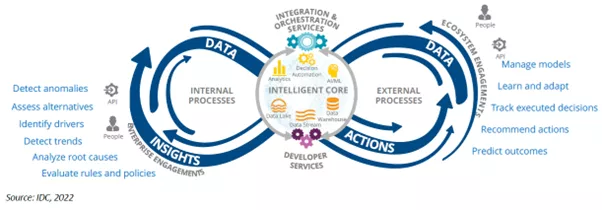How Banking CIOs Can Deliver Data-Driven Intelligence at Scale
With a focus on data-driven digital transformation, how do IT teams deliver differentiated value and increase customer satisfaction directly from technology investments?

Banking and financial services continue to be disrupted by leaner, new-to-market fintechs andchallenger banks, as well as shifting economic and regulatory conditions. There’s an arms race to leverage agile, best-in-class technology that consistently delivers top-performing customer experiences – all enabled by data-driven intelligence.
Advances in machine learning (ML), artificial intelligence (AI), and a proliferation of new and emerging data sets have helped open doors for these ambitious digital transformation initiatives to better serve customers. But analysts warn there’s mounting evidence that technology investments aren’t delivering on their promises and, more importantly, data and analytic investments alone are failing to deliver differentiating value to the business.
So, where’s the disconnect? One recent IDC data culture study suggests that less than a third (31%) of data and analytic teams are meeting expectations when it comes to the speed at which they respond to end-user requests. Clearly, businesses need to be agile and move quickly, but strained IT departments are struggling to keep up and continuously deliver a clear return on their technology investments.
Aligning with C-Suite Priorities
The good news? Business leaders are motivated to invest in the right technology to drive innovation and growth, and they are hungry for improving their ability to make more intelligent decisions. In fact, the vast majority (87%) of CXOs say becoming a more intelligent enterprise is their top priority for the next five years. But with only one in four (25%) financial service firms rating themselves as excellent in their ability to support decision-making requirements, it’s clear that the technology needs to catch up.
For IT teams, bridging this gap means not only meeting the ever-increasing demands for data access, up-to-date analytic models, and AI-powered applications – delivered at speed and scale across all business lines and use cases – but also helping ensure the tech delivers on its promises and desired business outcomes. By connecting technology investments to bottom-line results, the CIO offers a critical strategic lens to the institution in extracting maximum value from innovation initiatives.
Thinking Beyond the Data
Amid the pressure to deliver results, IT teams continually face challenges in keeping up with the day-to-day demands of the business. Supporting these data-driven technology initiatives with a seemingly never-ending and ever-changing multitude of use cases and requests may seem daunting. To make the most of limited IT resources, one place to start is simply by ‘flipping the switch’ on the data story.
IDC claims “the value of related data engineering, data science, and business processes depends on the decisions these capabilities drive – decisions that lead to actions and desired business outcomes.” Instead of focusing primarily on the data, why not reframe the collaboration with the business by focusing on improving the quality of the decision-making?
When approaching business requirements in this way, IT leaders are better positioned to identify and leverage patterns in decision-making that can apply across use cases. For instance, different decisions may consume common data pipelines, derived variables, features, and even predictive models.
IT can focus on delivering these foundational capabilities that can adapt and scale to meet the needs of the business, and the business can leverage these investments to enrich and improve its decision-making. When IT and business teams work together to build automated decision strategies using a rich, contextualized customer view from all available data and analytic capabilities, both teams realize synergies that ultimately improve customer experiences and drive business results.
Designing the Architectural Layer for Controlled Decision-Making
With increased regulatory scrutiny, CIOs in banking and finance need to work closely with their Chief Risk Officers and fellow business counterparts to ensure robust governance covering the use of data, analytics, and all aspects related to model risk management. When you introduce automated decisions, it’s also important to ensure all inputs used by individuals and teams across the business help them make more consistent and accurate decisions that comply with internal policies and external regulations.
Leading industry analyst IDC uses the term “decision control plane” to define the “architectural layer that sits over a set of decision-making processes to manage and control the holistic behavior of people and processes in the use of decision-making inputs such as data, business rules, and predictive algorithms.” It’s an approach to data-driven intelligence that goes beyond traditional backward-looking reports and dashboards to help identify and address bias in decision-making, better handle uncertainty and risk, enable tighter cross-team collaboration, and create a learning loop that continually feeds into future decisions.

Prioritizing New IT Investments with a Focus on Enterprise Intelligence
As businesses look to become more intelligent in an era of rapid technological advancement, differentiated value will only be realized by the most agile businesses. It’s for those that can harness the power of data, analytics, AI and machine learning capabilities at speed and at scale. They’re disciplines that are always worth the investment as they drive enterprises towards confident, automated, and intelligent customer decisions.
A disciplined decision-making approach, supported by the appropriate technology foundation, will set organizations apart from the competition. IDC research shows organizations that are better at ensuring consistency across decision-making processes were almost twice as likely to successfully implement results of data analysis – even at the height of a global pandemic.
Stay tuned for the next blog, when we’ll outline approaches for delivering decision-making capabilities within complex, fast-moving, and often resource-intensive enterprise software environments. (Hint: it’s not all about the tools).
How FICO Platform Can Support Your Digital Transformation Journey
- Download the IDC Technology Spotlight Whitepaper to learn how a unified decisioning platform can provide a decision control plane to enable enterprise intelligence at scale
- Read the Executive-to-Executive Guide to Successful Digital Transformation
- Review the FICO Platform Reference Architecture to understand how to connect, develop, and deploy data-driven decisions and AI-powered solutions
- Explore the FICO Platform
Popular Posts

Business and IT Alignment is Critical to Your AI Success
These are the five pillars that can unite business and IT goals and convert artificial intelligence into measurable value — fast
Read more
FICO® Score 10T Decisively Beats VantageScore 4.0 on Predictability
An analysis by FICO data scientists has found that FICO Score 10T significantly outperforms VantageScore 4.0 in mortgage origination predictive power.
Read more
Average U.S. FICO Score at 717 as More Consumers Face Financial Headwinds
Outlier or Start of a New Credit Score Trend?
Read moreTake the next step
Connect with FICO for answers to all your product and solution questions. Interested in becoming a business partner? Contact us to learn more. We look forward to hearing from you.
